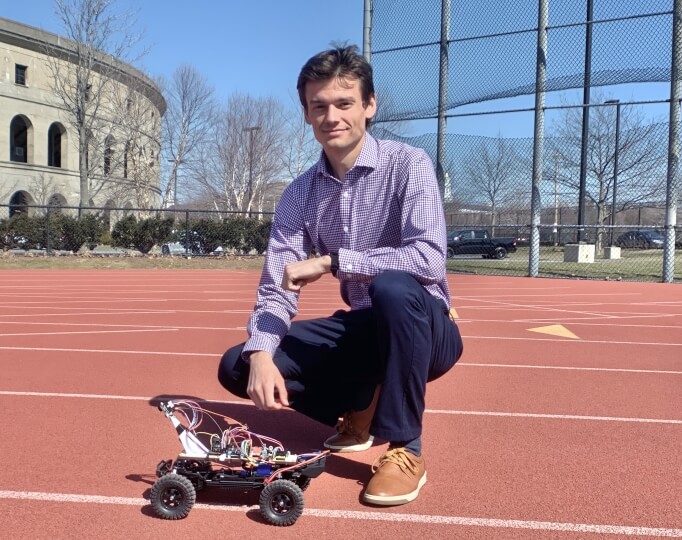Caleb Moore, S.B. '23, built a robot to pace runners around a track as a senior capstone project. (Matt Goisman/SEAS)
Engineering Design Projects (ES 100), the capstone course at the Harvard John A. Paulson School of Engineering and Applied Sciences (SEAS), challenges seniors to engineer a creative solution to a real-world problem.
Track Pacing Robot
Caleb Moore, S.B. '23, Mechanical Engineering
Advisor: Justin Werfel
Please give a brief summary of your project.
I built a track pacing robot, which is essentially a robotic training partner for a runner that paces them through their workouts. The goal of the project was to give solo runners a target to chase, simulating one of the benefits of running with teammates.
How did you come up with this idea for your final project?
I’m on Harvard’s Track & Field and Cross Country team. During the COVID-19 pandemic when we were all sent home halfway through the season, I recognized that without my teammates, running the times I wanted was proving more and more difficult. The inspiration for this project really came from my desire to have a training partner when I was away from campus.
Is there a real-world challenge that this project addresses?
This project addresses a gap in the market for individual runners who just want to go to a local track and run times that are challenging for them. Current solutions such as an LED pacing system installed on the inside rail of the track are really rare and can only be operated by whoever owns the facility, so individual runners really lack a pacing system designed for them.
What was the timeline of your project?
The project lasted two semesters, the first of which was mostly spent in the design and problem exploration phase. The second was spent in the building, testing, and analysis phases. After the design phase, I spent most of my time iterating and trying to improve my control algorithm.
What part of the project proved the most challenging?
Iterating on my controller design was the most challenging part of this process. Because line-tracking is an environment-specific task, I really had no way of knowing if a change was positive or not without testing. Even the smallest changes to my controller required me to bike to the indoor track late at night when nobody was using it, run my tests in a limited battery charge window, and begin iterating again the next morning during my 9 a.m. class.
What part of the project did you enjoy the most?
My robot went from being unable to follow a line at all, to slowly crawling around the track, to running around the track consistently without failing. Any time I made a leap forward in development and the robot was able to do something impressive, I felt a sense of relief and accomplishment.
What did you learn, or skills did you gain, through this project?
My advisor, Professor Justin Werfel, did a great job of providing feedback that kept me aimed in the right direction. The analogy of a coach keeping their athlete accountable is fitting – It’s a lot easier to say ‘no, I really don’t think that test is worth doing’ when you’re the one who has to go to the track alone on a rainy night. But that’s a laziness mechanism that you need to shut off if you want to do anything worth doing. Having an advisor who pushed me to take this project as far as I could in two semesters was crucial to the project’s success.
